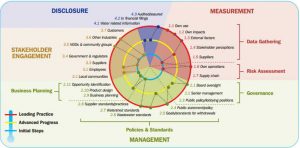Primary Functions
- Set out an analysis of water scarcity using the common business concepts and terminology of risk
Detailed Description
Water scarcity is likely to be one of the key challenges facing the world in the 21st century. In the next 40 years, global population is likely to increase by three billion people; there is likely to be a near doubling of water for irrigation to feed these extra mouths; more dams will be built to generate new hydropower as economies develop; competition from the water needs of bio-energy crops will intensify and pollution of water resources will continue. Freshwater biodiversity is also declining faster than that in other habitats. The implications are clear: meeting the needs of society and the environment in the future will be heavily constrained by the scarcity of freshwater.
The United Nations (2003) describes water scarcity as “The point at which the aggregate impact of all users impinges upon the supply or quality of water under prevailing institutional arrangements to the extent that the demand by all sectors, including the environment, cannot be satisfied fully.” This seemingly physical phenomenon is in fact normally a product of the interaction between complex social, economic and environmental systems. In practice, water scarcity, is more often caused by the nature of demand and the inappropriate allocation of water, rather than by total availability of the natural resource. Addressing water scarcity risk therefore requires better water management, stronger water governance and smarter financial investment. Water scarcity is a “governance crisis, not a [water] resource crisis” (Rogers, 2004). Indeed, at a global scale there is probably enough water to provide for present and future generations providing water management improves. To date, the track record on managing water effectively – almost anywhere in the world – is poor. For most governments water management is not, in practice, a priority, and societies largely fail to value and govern their freshwater resources adequately. Thus, despite significant strides in legislation and water-efficiency technology in recent years, water scarcity continues to be an all too common occurrence.
Water scarcity has impacts on many stakeholders including governments and businesses. Often there is a surprising degree of overlap in their interests with regard to reducing shared water scarcity risks. Consequently there is value in identifying common incentives that could motivate stakeholders to act collaboratively to reduce water scarcity risk. Leading private sector interests, national governments and other stakeholders are now using concepts and terminology derived from risk assessment to describe water scarcity and the range of responses to it.
Many WWF freshwater programmes around the world are focused on protecting basic ecosystem functioning through the maintenance of minimum environmental flows. These programmes are increasingly being implemented in partnership with governments, businesses and other stakeholders. This primer aims to set out an analysis of water scarcity using the concepts and terminology of risk with which these partners are familiar. Although risk to stakeholders can arise from poor water quality as well as scarcity, this primer’s emphasis is on the risks associated with insufficient water as opposed to quality of water, although the link between the two is acknowledged.






Reviews
There are no reviews yet.